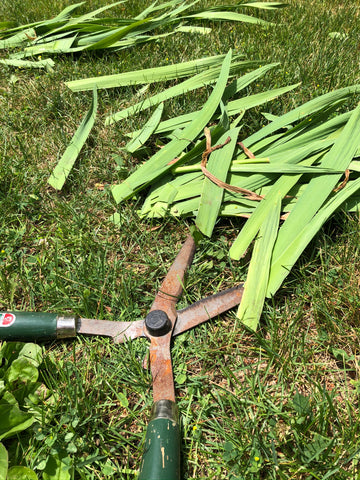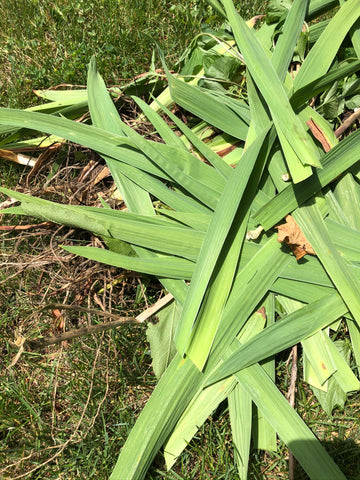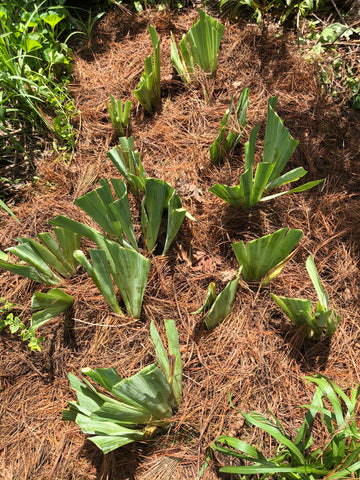
As you know I’m an advocate of messy gardens! A messy garden supports so many beneficial insects and other wildlife however the downside is that this practice can also foster pests we don’t want. One of those is the dreaded iris borer. I spotted this issue in one patch of bearded iris while showing my dad around the garden earlier this June. And then I found another patch of affected iris this week. Ugh!
So what is iris borer? The iris borer is the larvae of the Macronoctua onusta moth. The borers damage and destroy the rhizomes (the “foot”) of the iris. The larvae hatch in spring when iris leaves are just emerging from the ground. The larvae enter the leaves and tunnel into the plant causing damage as move their way down to the rhizome. Iris borers may be hard to see when they first hatch, but they grow up into nasty-looking, 2 inch long white/pink grubs. In addition to damage they cause themselves, the larvae introduce a bacterium that creates a foul smelling rot in the leaves and rhizome. (And from experience, it really does stink!) The leaves of an affected plant will be tatty and ooze this stinky fluid. Affected iris will discolor, wilt, and die in late June and July.
When assessing your iris, remember that iris borer symptoms may mimic other common iris diseases such as bacterial soft rot, leaf spot and iris scorch. Once you know you have iris borers, you must deal with the issue if you want to save your beloved iris. If you leave these guys to continue to attack your plants, the damage ends in compromised, mushy, stinky rhizomes, damaged stems and no blooms the following year.
So how does a messy garden support iris borer infestations? First, we have to understand the insect’s life cycle. Iris borers overwinter as eggs on both iris and other types of garden debris. The eggs hatch in spring and the larvae bore into the iris leaves. Then, these nasty larvae tunnel down through the leaves and eventually reach the rhizomes below ground. After munching on the rhizomes, they move into the soil and pupate. The adult cutworm moths emerge. The adults repeat the cycle by laying their eggs in late August and September.
So the key to break the cycle is “iris tidiness.” If there is no leftover foliage in which the eggs can overwinter, there will likely be no (or very few) caterpillars in the spring. So, it is important to remove old stalks and leaves in the fall after the iris are hit with frost. Also, it is essential to monitor your plants in the spring (April and May). If you begin to see signs of tunneling, prune off the affected leaves just below where the damage is. The caterpillars are small at this stage (1/4 inch) and you can squish them between your fingers (if you like) and then throw the leaves in the garbage. (Don’t compost the affected leaves.)
If you’re like me and you don’t notice this mess until mid-summer, you have more work on your hands. If you are seeing yellowed leaves and rot at the base of the stalk, you have to dig up the plants to inspect them. Knock off all of the dirt. Cut away rotten parts with a sharp knife (and remember to throw these in the garbage). Place the remaining rhizomes in a bucket of water that is 9 parts water and one part bleach. Let the plants soak for 5 to 10 minutes. The borers will drown. Place the plants in the sun to dry and then replant. I cut off the leaves to make a small fan before planting. (See my photos.)



Unfortunately, our showstopper, gorgeous bearded iris is the type of iris most affected by iris borer. From researching, Siberian and dwarf iris have few problems. If iris borer is a persistent problem, you will have to consider planting resistant varieties. Luckily, I’m not at this stage yet.
So, get out to your garden and check your iris!
Oh and when you look at my photos, check out the pine needles I use for my mulch. These are from the pine trees in my yard. Pines needles are super easy to use as mulch and for me, definitely at the right price.








